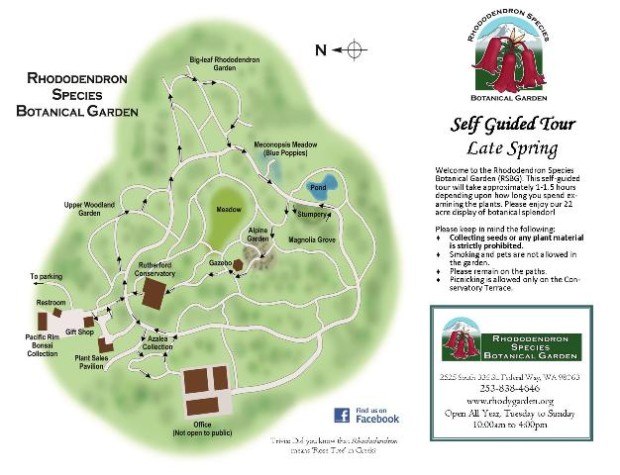Please follow the black numbered signs for this self-guided tour. Enter the courtyard and walk straight ahead to visit #1 Menziesia ciliicalyx var. multiflora* from Japan. This deciduous shrub has blue green foliage that is extremely attractive. Menziesia is a member of the rhododendron family. Follow the sign to the main path and you will see #2 Viburnum plicatum var. tomentosum, Doublefile Viburnum* native to China and Japan. This easily-grown deciduous shrub provides beautiful white blossoms in the spring as well as stunning fall color.
Take the left path between the two deciduous magnolia trees and you are in the Upper Woodland Garden which features many rhododendrons with thickly indumented leaves (a thick furry coating on the lower surface). The magnolia on your right is #3 Magnolia sargentiana var. robusta from China. This early spring, pink flowering magnolia has among the largest flowers of any magnolia. The one on your left is #4 Magnolia hypoleuca from Japan. Its cup-shaped creamy white flowers appear in May and its huge leaves grow up to one and a half feet long!
Keep going and you will see #5 Speirantha convallarioides, False Lily of the Valley on your left. This is a choice and very slow-growing evergreen groundcover with fragrant white flowers in spring. Next to Speirantha is a patch of #6 Coptis laciniata, Goldthread on your left. This slow-spreading groundcover is native to the Pacific Northwest. The name comes from the golden yellow rhizomes that creep just beneath the soil surface.
Follow the sign to the main path and make a left turn. Take the next path to your left to visit the Big Leaf Garden. Most of the big-leafed rhododendrons eventually become very large trees in their native temperate rainforests in the Sino-Himalaya.
Straight ahead you will see #7 Podophyllum pleianthum, the Asian May Apple. This is a beautiful woodland plant with umbrella-like foliage. The plant is used medicinally in its native China. Across from the May Apple is #8 Acer palmatum ‘Emerald Lace’. The very finely-dissected leaves open yellow-green, turn a deep-green in summer and change to bright burgundy in fall. Follow the sign to enter the newly completed #9 Big Leaf Forest, where we feature some of the hardiest Big Leaf species. Here, you will find Rhododendron praestans, watsonii, kesangiae, rex, and montroseanum. In 10 to 15 years, you will be walking under the large rhododendron trees beneath a grove of native conifers. Continue forward to #10 Matteuccia struthiopteris, the Ostrich Fern*. The new growth of the emerging fiddleheads is very beautiful.
Follow the sign and you will see #11 Rhododendron rex* on both sides. This plant has extremely attractive shiny deep green foliage with a thick gray to buff indumentum beneath. In China, where it is native, it can attain heights of up to 45 feet. You will also see #12 Polygonatum the Giant Solomon’s Seal*. This shade-loving plant produces arching stems with clusters of delicate white flowers dangling beneath the leaves.
Now, make a left turn on the main path. Keep going until you see the Himalayan Blue Poppy meadow on your left. Check out the new growth of #13 Cardiocrinum giganteum* which looks similar to a shiny green hosta. This is the Himalayan Giant Lily which can grow to 12 feet tall with masses of six inch long fragrant flowers in June. The clusters of fuzzy leaves are the Blue Poppies*.
Keep going along the main path until you see the Hardy Fern Foundation’s Victorian Stumpery (#14) on your right. A Stumpery is an English Victorian period garden design that romanticizes nature. The design uses tree roots and stumps placed on their sides or upside down creating a “Wild Scene” which is then planted with thousands of ferns and other woodland plants. Have a seat on the cut cedar-log bench at the top of the Stumpery and enjoy the view of the pond garden.
From the Stumpery, walk along the main path back toward the blue poppies and take an immediate uphill left at the sign, just past the Stumpery. Go up the hill to the Alpine Garden (#15). Please take some time to explore this unique garden area. Most of the plants here are found at high altitudes in the mountains of Asia. Walk up toward the Gazebo which is surrounded by #16 Rhododendron degronianum ssp. yakushimanum*. This species is found only on the very top of an ancient volcano on Yaku Island, Japan. The apple-blossom pink flowers will eventually fade to pure white.
Follow the sign for the Rutherford Conservatory (a separate self-guided handout to tour the Rutherford Conservatory is available inside).
From the front door of the conservatory, head back to the road (main path) and go left to visit #17 the Azalea garden. Please explore and enjoy this part of the garden filled with color and fragrance. The beds in between the azaleas are filled with Iris sibirica ‘Caesar’s Brother’ and Primula prolifera. Here are some of the azaleas you will find.
#18 Rhododendron atlanticum has blue-green foliage and very fragrant flowers. It’s native to the coast of the eastern US.
#19 Rhododendron luteum* has bright yellow flowers with a wonderful fragrance. Beautiful red fall foliage color is another attractive feature.
#20 Rhododendron molle is from China and Japan. It is easily grown in sun or partial shade.
#21 Rhododendron canescens is another fragrant azalea that is native to the eastern US.
Walk back toward the conservatory as you enjoy the view of #22 Rhododendron kiusianum* on your right. This extremely variable and easy to grow plant is native to mountain slopes on the main island of Japan. It is very slow growing and is popular for bonsai and container culture.
From here, you can walk back to the Visitor Center where you started. Many of the plants you viewed today are available in the RSBG Garden Shop Nursery but are quite rare in regular retail nurseries. We hope you enjoyed the self guided tour today. Please come back and visit the garden soon!
* For sale at RSBG Nursery

